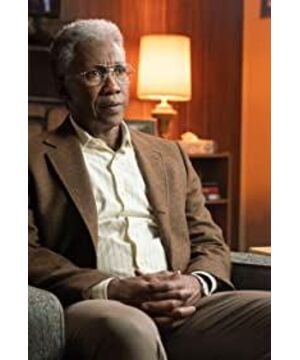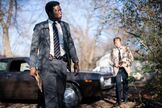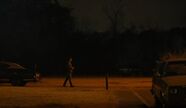Have you ever been in such a situation
1. After the incident in 1980, in the thunderstorm, the sad-faced Wayne was supervising the state police to search along the river, but Julie had not been found.
As soon as the camera turned, a policeman was collecting evidence on William's bicycle, which was found by Wayne.
Young Wayne and Rowland emerge from the autopsy, and the timeline cuts to a forensic Q&A in the '90s.
2. Wayne's first sentence is "You have the autopsy report, I don't need to read it." This sentence seems to indicate that his eyesight is sharp, but it may also be a hint to Wayne's dyslexia, which will be mentioned later.
Middle-aged Wayne recalled his identification of William's body: "Blunt trauma, broken neck. Someone twisted his neck, and then took him to the cave and put his hands like that."
Wayne pressed the two detectives to reveal a clue about Julie's appearance in the Oklahoma burglary, but the other side refused. One of the detectives, Allen, promised him he would tell him later.
Wayne reluctantly continued the investigation.
3. Back in 80 years, Wayne and Roland continue to investigate this headless case.
The first place they came was where the victim's father, Tom, went to work. It was a shop that made parts for school buses. There were more than a hundred local workers in the shop, and they all interviewed them. "School bus" and "local workers" imply that workers are familiar with each other's families, a message that only adds to the fog.
Afterwards they went to a shop specializing in dolls. Wayne squatted in front of the window of a doll shop. There were many dolls in it, but they were all industrial products, and the straw dolls were handmade. So of course the shop owner shook his head and said that he had never seen or made such a doll.
Middle-aged Wayne went on to recall, after which they took Woodard to the police station for questioning.
According to Woodard's statement, he returned from the Vietnam War in 1972, when the Vietnam War basically ceased fire and was in the negotiation stage. The war led to the collapse of his marriage with his wife, who left him in 1976 with two children. Woodard missed the full family life of the war. He thinks that he is not the same kind of person as those drug-drinking and alcoholic Ah Fei, and he hates that others see him as a homeless man, because he also has a house and bought it with his own money.
Roland introduced that he was a mechanic during the Vietnam War, and Wayne was a distant scout. Roland said Wayne's nickname on the battlefield was "Purple Hays". Bean friend Brix believes that "Hays" is homophonic with "Haze (smoke)" and agrees with his statement. "Purple" refers to his complexion, and "smoke" refers to his elusiveness as a distant scout, coming and going without a trace.
"Purple Haze" is a reference to the song of the same name by legendary guitarist Jimi Hendrix, who turned his electric guitar into a bomber. Below is his performance of the American national anthem at Woodstock in 1969.
Jimi Hendrix - The Star Spangled Banner
Woodard admired Wayne's troops very much, and the two had a basis for chatting. Woodard and Wayne live in different ways. Wayne couldn't find the point of clocking in for work, but he still lived a life that Woodard resented. Woodard is a person who cannot adapt to society, which is related to his experience and the social environment of racial inequality. In the current life of isolation and despair, he even wished to live during the war, when at least every day he had a thought, "Don't kill people."
But the war was an entirely traumatic memory for Wayne, who revealed that it took him a year to emerge from the war. In fact, he didn't come out completely.
Roland interrupted the old-fashioned conversation between the two. He had a prejudice against Woodard, so he asked some excessive questions, which almost made it clear that Woodard was suspected of harming children.
"Have you ever been in such a situation? You can't let go, but you can't be nostalgic. You're in a dilemma, and you're suffering both physically and mentally." This is Woodard's deep-rooted longing for his wife and children. It is also the title of this episode.
The camera is on the face of the young Wayne, gradually approaching, his expression is like a pain.
4. So at this time, the timeline cuts to 15 years, and the old Wayne returns to the Westfinger community where the crime happened thirty-five years ago, looking sad. This shot follows Woodard's words and the young Wayne's expression, implying the old Wayne's "unable to leave, and no way to linger" mood.
Son Henry asked him if he remembered the place because he was already very forgetful. But no matter how forgetful he was about this place, he couldn't forget it.
5. The timeline cuts back to the 80-year-old Westfinger community, telling stories that are in the same scene in different timelines.
At the official briefing on the case, people panicked. The government official (should be the court's) Gint was "talking about" on stage, and the entourage standing next to him should be the detective Alan who made a forensic recording of the middle-aged Wayne ten years later.
In the speeches of the community residents under the stage, Woodard was severely targeted with a discriminatory tone.
Wayne distributed information to the parents at the scene, a picture of the missing Julie, and a picture of William's red backpack of the same style.
When William went out, he was carrying a red schoolbag. The scene in the first episode actually made an inadvertent emphasis, but this is still a detail that is easily overlooked.
Is it necessary to carry a school bag when you go out for a while by bike? And William's schoolbag was bulging, obviously containing a lot of things. What are you wearing?
6. This time the timeline was switched based on Allen's face, which was cut from 1980s to 1990s.
It is speculated from the conversation between Wayne and Allen in the middle age that the official who spoke at the press conference was Gerald Gint, who was already the state attorney general in 1990. In '80, he was seeking re-election to his then-post. From some of the conversations in this episode, it is clear that Gint used his personal power to intervene in the case badly and even destructively for his re-election success.
The 1990 reopening of the investigation appears to have been requested by Allen. Wayne teased Allen, saying that Gint's promotion must have played a big role in your complaint.
7. The time line goes back to 80 years. After the conference, Wayne and Emilia, who also came to the conference, met again. Wayne gave Emilia a copy of the straw doll's photo to help ask clues from the school kids.
8. The time line is cut back to 15 years. In the father-son conversation, it was revealed that Henry also has a younger sister, Rebecca, but the relationship between the father and daughter is not good, which may be related to the death of his mother.
Wayne mentioned that Emilia and his views were always at odds, and they seemed to have their own views on the case back then.
9. The time line was cut back to 80 years, and the boss introduced the newly added special investigation team to Wayne and Roland. Obviously, this was a nail that Gint specially inserted, in order to prevent this case from going awry and becoming a stumbling block for him to seek re-election.
The task force was assigned to investigate Julie's disappearance, while Wayne and Roland were only allowed to investigate William's death. This distribution is also to suppress the enthusiasm of Wayne and Roland, lest they "bad things" in order to find Julie.
Wayne asked the two detectives of the special investigation team about the next investigation plan. One said that they would issue a notice and set up a card inspection, and the other said nothing at all. It can be seen that they are not here to actively investigate the case, and will not be of any help to the progress of the case.
Wayne and Roland ignored this "bullshit" assignment, and they continued to investigate the case as a whole.
10. They attended William's funeral. Wayne and Roland find Lucy's younger brother Dan, who used to live in William's room.
When questioned, Dan unconsciously lowered his head and broke his hands, showing his inner nervousness.
Dan thinks Tom is weak and Lucy should find a stronger man.
Wayne and Rowland then questioned Tom's parents, who revealed that Tom had worked at sea for some time, and they believed that Lucy had an extramarital affair during that time, which led to her becoming pregnant with Julie.
11. Back in 15 years, the female reporter introduced the discussion on the Purcell case on the Internet. The words above showed that the judgment was wrong (False Convictions).
After two investigations in the 1980s and 1990s, why is the judgment still wrong? If the judgment is wrong, the wrong person must be arrested. Who was caught, Woodard?
The female reporter suddenly asked a question about pedophilia, apparently with the intention of leading the elderly Wayne to speak in that direction.
Female reporters also used celebrities like Reagan and Bush as "argument" weapons, and quoted netizens as saying that straw dolls are a sign of pedophilia.
These speculations were pushed down impatiently by Wayne.
Another question from the female reporter hides the cryptic message: "May I ask, given what happened in 1990 and your discharge from the military, do you feel that your clues and reasoning are discredited because of your racial identity?"
It can be seen that Wayne's views have not been taken seriously in the investigation of the case. But what happened in the 1990s? How does his retirement relate to his racial identity? Is his underappreciation simply because of his racial identity?
The topics of "pedophilia" and "racial discrimination" raised by female reporters are echoed in the second half of this episode.
But from her point of view, she was only intentionally leading Wayne to say something that appealed to the TV audience. In order to achieve this purpose, some bells and whistles are also used.
This made Wayne dissatisfied, and he looked back at his son and thought, "Why is this woman talking less and less?"
The female reporter felt that she was going to be driven away again, so she quickly grabbed the photo of the doll, and said solemnly, "Anyway, the doll is an important clue, there is no doubt about it."
Wayne then reluctantly replied, "It's all Emilia's credit."
12. The timeline cuts back to 80 years, and Emilia interviews the children on the playground with a photo of the straw doll.
The camera shows the young man Fei in the distance, Freddy is grabbing the collar of the flat-headed boy and questioning him. Both had been given oral testimony, and Freddy was apparently blaming his partner for saying something he shouldn't have said during his testimony. It is also good to judge what this should not be said.
According to Freddy, they just bumped into the siblings on the road, but didn't see them in the park afterwards.
The flat-headed boy said that the brother and sister appeared in the park.
The two confessed differently, and Freddy, the leader, was naturally angry.
Emilia gets an important clue from Mike, who sits by himself and plays a game.
Mike, the boy, appeared in the first half of the first episode. After the two brothers and sisters rode their bikes out, the first person they met was him. At that time, Julie and Mike greeted each other with a smile and a wave. Emilia later said that he thought Mike liked Julie, which should be true, and he was also very sad that Julie's life and death were unknown.
Mike said that on Halloween, he saw a straw doll, and that night the children played trick-or-treating in the community, and Julie had a straw doll in her hand.
13. The son's funeral was over, and the daughter was not found, but Tom went back to work. All the workers looked at him as if they had seen a ghost. Tom was silently pushed out. What are these colleagues thinking? Nothing more than some contempt and suspicion of Tom. If Tom lost the children, they would think he was the worst kind of parent; if Tom himself killed two children, then Tom was a dangerous man. After all, who wants to be close to such a person?
Tom, a middle-aged worker at the bottom of the society, lost his job, directly because he lost his child. This is the irony of our social group. When faced with a crisis, we are often aimed at the places and people that should not be aimed at.
14. Emilia brings Mike to Wayne and Roland for questioning. With the help of Emilia, little Mike provided a relatively complete and crucial clue.
On Halloween, the children of the community went out to play trick-or-treating.
Mike didn't play with Julie the whole time, and the kids split and closed several times that night.
When Mike first met Julie, she didn't have a straw doll yet. But when the game was over and the kids got together, he saw that Julie already had a straw doll.
He saw two probably adults talking to Julie, dressed as ghosts in sheets.
When they played this game, they did not ride bicycles, but walked, so the scope of suspicion was narrowed down a lot and would not go beyond the community.
Let me mention here, in fact, the element of Halloween was implanted in the first half of the first episode. William and Julie rode their bikes out, the first witness they met was Mike, and the second was the neighbor Margaret, who was taking down the "pumpkin" hanging in front of the door.
I have a hunch that Margaret might be interacting with the kids on Halloween.
15. Tom, who was walking home after losing his job, was picked up halfway by Wayne and Logan. During the interview, Tom shared some information about him and his wife.
The two met 13 years ago, in 1967. After 3 months of knowing each other, they got married because they were pregnant with William. After marriage, there is a lack of emotional foundation, and the relationship between husband and wife is not good.
16. Arkansas State Police Headquarters, Wayne and Rogan report the key clues of the straw doll.
I think there is something to be said here. According to the ending paragraph of the first episode and the paragraph of this episode, it can be determined that there are three straw dolls in total, one of which was obtained by Julie on Halloween. Later, Wayne found William's body through two straw dolls, and another straw doll was found near the tracks.
Is it possible to speculate that the straw doll Julie got on Halloween was in William's bulging backpack when the siblings went out? Because Wayne searched Julie's room, except for many puppets and porcelain dolls, there should be no straw dolls.
Why do they take straw dolls to the park? Did the siblings make an appointment with someone else to play grass doll-related games in the park? Why did William's body appear in the cave? Did the murder lead him through two straw dolls and kill him? Was the straw doll found near the rails the same straw doll Julie got on Halloween? Was the straw doll on the rails lost when Julie was taken away?
At the police headquarters, Wayne and Rogan believe that the next step should be to start the line where children play games on Halloween, and search the residents along the line. Wayne said that while it was out of order, residents were sure most of them would cooperate because it was at stake for their safety and that of their children.
When trying to get the approval of government officials, it was mainly Logan who was arguing with the other side, and Wayne just said the plan. Apparently the skin color did give Wayne some restraint and neglect.
With his re-election imminent, Ginter, an official at the site of the crime, disagreed with the burglary because it would affect his voter approval ratings.
17. Logan got information about a suspect, Ted, from an informant in the Police Department's Weathering Unit. The man, who was jailed for seducing and having sex with minors, now lives near the Westfinger community and still hits young girls.
18. At the bar, Wayne met Emilia. A flicker of doubt appeared on Emilia's face. But it's not necessarily related to the case, she may just feel that Wayne is interested in herself.
Wayne has indeed never been to this bar, so it can be seen that Wayne's goal is Emilia.
During the conversation between the two, Emilia talked about her upbringing background.
A native of Arkansas, he attended Arkansas State University but dropped out his junior year, went to San Francisco on the West Coast with a friend, participated in an anti-war march, and joined the Black Panther Party. Later, some "bad things" happened. In 1974, she returned to her hometown alone, continued her studies, and got her degree.
The Black Panther Party is a black organization established in 1966. They hold firearms and hold high Mao's quotations to fight for equality and freedom. Amid the FBI crackdown and internal divisions, the Black Panther Party disintegrated in the early 1980s. The Black Panther Party also appeared in the famous "American History" film "Forrest Gump".
Judging from Emilia's words, that friend should be her boyfriend at the time. If something bad happened, her boyfriend should have been sacrificed in the conflict between the Black Panther Party and the official. Frustrated, Emilia returned to her hometown and entered the regular track. After graduation, she became a teacher and became an ordinary person.
Judging from the radical behavior of Emilia in her student days, she has a flame of idealism in her heart, which should be related to her active involvement in the case later.
Emilia mentioned that she wanted to be a writer, and she did become a writer later. "Life, Death, Full Moon" was just the beginning of her writing, and she published several books later.
Wayne mentions that he has dyslexia, and at the end, the elderly Wayne mentions that he has never finished reading Emilia's book, echoing this.
What they both have in common is that they are both unmarried. This is interesting, seems to tell us that two unmarried people who meet will turn into marriage (just kidding).
The two also exchanged their quirks with each other, which means the two have taken their relationship a step further. It can also be seen from the body language that Emilia approached Wayne and shortened the social distance.
Wayne finds out on the bar TV that Gint has made the key Halloween clue public for his career. He takes a tantrum at his partner, feeling that because he's black, no one listens to what he says.
After the two calmed down, Rogan threw the paedophile Ted's information in front of Wayne, because the officials leaked the only clue, they had lost the opportunity, and the two decided to take extraordinary measures to illegally detain and torture Ted.
Wayne was going to take some stimulants, and Logan told him that there were some in the car, when Wayne turned his head and was facing the audience outside the screen again. With a thunderous sound representing memory switching, the timeline returns to 15 years.
19. Of course Wayne won't tell the details about himself and his partner in private. He also didn't say anything about the part about sabotage and rat. This is actually normal.
Wayne told reporters about the situation in the community after the clue was released, and there was panic in the town at that time.
In response to what he described, the time line was cut back to the community of 80 years, and the streets were empty, the doors of every house were closed, no one was seen outside, and the school bus could not pick up a single student.
20. The two of them came to a restaurant, sat down left and right, and sandwiched Ted in the middle. They took Ted to a secret place and began to torture him. The attitude of the two shows that they have regarded Ted as the murderer.
Under pressure, Ted was hired to work at a daycare on the day the crime was committed. The partners arrive at the daycare and learn that Ted leaves at 8pm.
21. With a thunderclap, the timeline swayed into 90 years, and the forensic scene finally ended. The middle-aged Wayne and Allen had an interview in a restaurant, because Allen had promised to tell him some news after Julie's fingerprints were found.
The fingerprints left at the scene of the theft can only prove that Julie has been in the store and cannot tell whether she is a customer or a thief. The video of the theft scene was destroyed, but the surveillance of the three days before the incident is still under study.
Wayne learns that there is a lack of professional investigators at the crime scene, which may be why Allen is looking for him. For some unknown reason, Allen parted ways with Gint as if his conscience found out. He applied to reopen the Purcell case to overturn the previous judgment of Gint's team.
Wayne recommended Roland to Allen. From Wayne's tone, it can be seen that the two partners are not working together now.
22. Another thunder, back to 80 years. In these recent episodes, the rhythm of switching is getting faster and faster, and the sound of thunder is constantly sounding, which makes the tension even stronger.
The two partners took Ted to the wilderness, and Roland deliberately frightened Ted so that he would not dare to come back to Westfinger. Then Wayne talked about how to deal with Ted, put him in custody, let him violate the parole rules, and the police will take him back to the area to continue serving his sentence the next day.
Apparently after their interrogation and investigation, they no longer believe that Ted was the murderer in Purcell's case.
Wayne threatens Ted that he'll let the niggas in jail fuck him if he dares to tell the truth that they've forced him to confess.
It's interesting to say this from a black man. The big background is that black people are discriminated against, but the way the discriminated black people fight back is to "admit" your discrimination, I am a nigger, but I can still kill you.
I think this mentality is similar to the situation where discriminated women become extremely masculine strong women in male society.
This is a seemingly active but passive resistance.
The two received an order from the police department on the way, and a new situation occurred at Purcell's house. The two immediately drove to the car.
23. A sound of thunder interrupted the events of 90 years. After the middle-aged Wayne and Alan talked, he returned home. The two children were playing at home. He walked into the kitchen with a sad face and took out another bottle of wine. He saw the sample book "Life, Death, Full Moon", and Emilia walked out happily.
Wayne sat down with a heart full of thoughts, and Emilia, who had a heavy background, also looked over worriedly, just at the audience outside the screen. The thunder sounded and the time switched.
24. Elder Wayne is interviewed with Emilia's first book.
The reporter's words continued to add more fog. According to her, Wayne was involved in the investigation again after 90 years, but it seems that he lost his job because of it, or he voluntarily left the police station, and something bad happened to Tom and Julie.
25. The close-up profile depicts the old-fashioned tough guy expression of old Wayne. The thunder shook and jumped back to 90 years.
Henry shared his progress in sports at the dinner table, but Wayne bowed his head and pondered, deaf, and his daughter smiled at him, and he returned a wry smile.
Wayne looked at his daughter, thinking about Julie who had been missing for ten years but suddenly reappeared. If Julie was alive, Julie would be an adult by then.
Emilia saw that Wayne was worried and followed to the study. From the dialogue between the two, it seems that the Purcell case has not been closed from 1980 to 1990, and Wayne has been investigating this case for ten years. But it may be a private investigation, because from the middle-aged Wayne and Allen's conversations, it is clear that the case was decided in the 1980s, otherwise there would be no reopening of the case.
Wayne tells Emilia that Julie is still alive. Does this mean that the views in Emilia's forthcoming book will be upended? But why does old Wayne still say that this book is the best ending Emilia has written for the case?
It seems that after the restart of the 90-year case, an even greater tragedy occurred. Is it a good thing that Julie doesn't show up?
26. Lucy was crying on the sofa when she arrived at Purcell's house after receiving the order, and was hugging her neighbor Margaret. The morning after the siblings disappeared, police were searching the field, and Margaret was with Lucy as the Purcells watched the live news at home. This person always seems to appear inadvertently, and the Halloween "pumpkin" in front of her door, and the brothers and sisters warmly wave to them when they go out, but the brothers and sisters don't look back at her, these details are interesting. It should be certain that Margaret is connected to the case.
And when she saw Wayne coming in, she glanced at her, Margaret's left hand was supposed to comfort Lucy, but when she met Wayne's eyes, a trace of panic flashed in her eyes, and her hand shrank again go back. This is a frightened expression and behavior.
The Purcells received a piece of paper, and the other party was very cunning, because it was not written with a pen, but with a child's letter sticker. A few words above:
"Don't worry, Julie is in a nice and safe place, and the kids will be happy. Stop looking, let it go."
Aside from the preconceived notions of kidnapping and murder, if you look at it from a common sense, this letter doesn't look like it was written by a murderer. Instead, the tone seems to be bitter and caring for the child. And from the tone, Julie was indeed taken away, not by herself.
The letter implied that Julie was having a bad time at the Purcells. What is "bad"? Does it mean that Lucy and Tom often quarrel? If that's the reason, there are neighbors in the community who know about it, Tom's parents (Lucy's parents are no longer alive), Dan who lived here, and maybe Emilia.
If this person took Julie for her good, we can ask, is Julie so bad at Purcell's? Although her parents are not in harmony and her mother is not at home very much, Julie has not endured hardship after all, she can go to school and eat, and her parents seem to love her very much. Who would break up this family so self-righteously?
And, even if we agree with what this person said, Julie is not having a good time. So, is William doing well? Why not take William with you too? Could it be that something went wrong when he wanted to take William away? Or did this man kill William? How could someone so sympathetic kill one child while saving another?
But William's death and Julie's disappearance are not necessarily the same person or group of people, we must pay attention to this.
In fact, if Julie was taken away and William was not taken away, we can also implicate a clue that Tom's parents think that Julie is not Tom's child.
It looks like this is true. And when Tom and Lucy quarreled, he also said that Lucy was out looking for a man. So that means Lucy cheated on her years ago and is still misbehaving (if what Tom says is true). So, has Lucy cheated on the same person all along? If it is the same person, then this person is most likely an acquaintance.
The series should reveal Jolie's true origins in later episodes. If Julie is not Tom's child, then Julie's disappearance is likely to be related to the blood father.
If Julie is indeed taken by her biological father, I might as well make the most outrageous speculation that this person is Dan, and it can't be more outrageous than that anyway.
If this outrageous conjecture holds true, then Dan's coming to Purcell's is a good reason, and Dan's going to live in William's room, and it makes sense for him to punch a hole in the wall.
But the hole in the wall is not necessarily the one that Dan made.
If Julie was taken away by her biological father, then Lucy is probably involved, and Margaret is most likely to help.
I still can't help but use my imagination and let's talk nonsense first. In fact, Mike's testimony gave me two important inspirations.
That's what little Mike said when he testified that when he first met Julie on Halloween, she didn't have a straw doll, and he and Julie split once or twice, but it wasn't long, and they both walked Begging for candy, not riding a bike. And he saw Julie talking to two supposedly grown-up people dressed as ghosts in sheets.
Let's recall the first episode, there is a scene showing William and Julie riding out the door, from that scene we can get a rough idea of the relative orientation of the residents in the community.
If we take this orientation and apply it to Mike Jr.'s testimony, we'll have some inspiration.
William and Julie rode their bikes out, and the first witness they met was Little Mike, indicating that Little Mike lived very close to Purcell's house. Little Mike himself said that he lived on the next street. I took a closer look and felt that it was a right-angle bend from Purcell's door, and there was only one way to go out and go forward. In other words, William and Jolie went out to play on Halloween Eve, and probably took the same route that went out by bicycle. Well that night, William and Julie would also meet Mike soon, before Julie got the straw doll. Mike and Julie were separated once or twice, but it wasn't that long, and they were walking, which meant that William and Julie probably didn't walk as far that night as they did the day they rode. That night, William and Julie must have passed by the fat neighbor Margaret's house later, and the straw doll may have been given to Julie by Margaret. Of course, this is just a loose guess, but the series deliberately shows the relative positions of Mike and Margaret, so there is reason to be suspicious.
As for Mike's claim that he saw Julie talking to two probably grown-up ghosts in bed sheets, that thread easily reminds me of Freddy and the teenage boy. Because first of all, there is a devil's pattern on the chest of the flat-headed boy, which shows that the bad boy likes this subculture. When they look at William and Julie riding a bicycle to the park, their eyes are very unfriendly. possible. In addition, there is another piece of evidence, Mike didn't insist that it was two adults, his original words were "adult, maybe", what kind of person is wearing a sheet that makes you think it may be an adult Woolen cloth? I think it's taller teenagers. Freddy and the flat-headed boy fit this profile.
The above is a guess that can't help but talk nonsense, or it's better not to take it seriously.
Back to the plot itself.
27. The time line is cut to 15 years. The elderly Wayne and his son Henry's family are eating at the table. It seems that now he is living with his son and daughter-in-law.
He said that he had never read the book written by his wife because it had too much to do with himself. Is it because of this or because of his dyslexia?
He hoped that Henry would call his daughter Rebecca back.
Henry told him that Rebecca was in Los Angeles, and that Wayne's performance proved his memory deficit. He didn't remember his daughter's occupation and place of work.
And Rebecca seems to have a deep conflict with him, so she doesn't come back and doesn't contact him very much. The camera kept showing photos of Emilia, as if to express his nostalgia for his wife.
28. The camera is turned to a frontal close-up, the background sound is loud, and the scene is switched, and a frontal close-up is connected. This kind of shot has a kind of expressive power that grabs people's souls and grabs people's souls.
And I noticed that the show seems to incorporate moon elements in many shots. In addition to the real moon, there are chandeliers, street lamps and other moon-like substitutes (you can look back for it). For example, street lights, when using the blurring method, the street lights are blurred into the appearance of a full moon. As shown in the shot below.
This time the scene is switched, and it is not the timeline that is switched.
Judging from the street signs, the old Wayne was standing in front of the Purcells.
A car with lights on behind him was parked, revealing that he was driving.
But Wayne, who was wearing pajamas, looked at the dark house of the Purcells in a panic, and obviously didn't know how he got here. He has severe amnesia.
At the same time, this ending echoes what Woodard said. When Woodard was under investigation, he asked Wayne, who was still young at the time: "Have you ever been in this situation? You can't let go, but There is no way of nostalgia, dilemma, mental and physical torment.”
Standing alone at the door of Purcell's house at this moment, the old Wayne, who doesn't know where he came from, doesn't know where he is going, isn't he in this situation?
The following song should be the source of the title of this episode. The song forms an intertext with the theme of this episode "I can't part with it, I can't be nostalgic".
Jane Morgan-Kiss Tomorrow Goodbye
Talk about True Detective S03E03: Trying side by side again today
"Detailed Detective"
"Details of Mrs Maisel"
"Tell me about a genius girlfriend"
"Detailing Mrs. Wilson"
"The Rabbit Republic"
View more about The Great War and Modern Memory reviews











